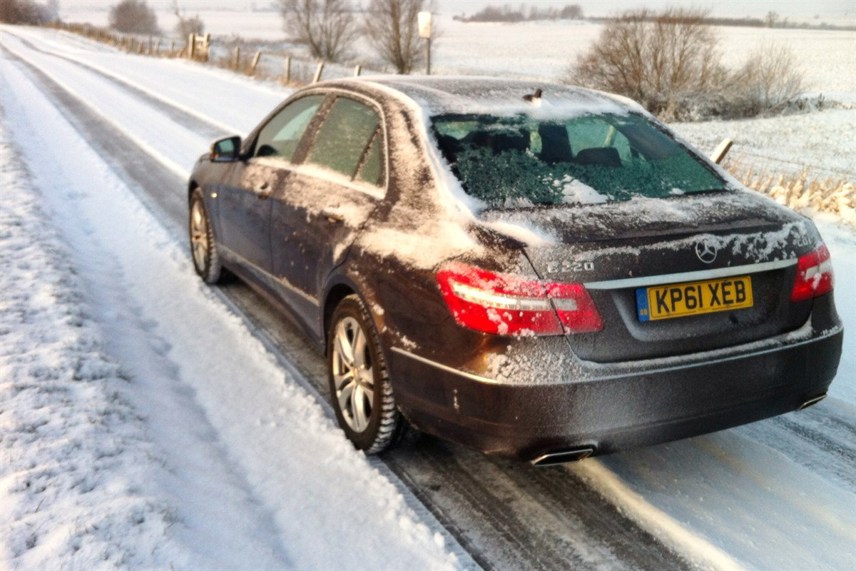Review
No faults were recorded on the Mercedes-Benz E-class during its six months with us. Stress-free motoring came as standard – literally so, as it delivered driver and passengers to meetings and social occasions unflustered and with minimum fuss.
That period included almost four months with winter tyres – albeit the weather was not conducive for a true test of these rubbers’ capabilities in the cold and snow.
They did have a minor impact on fuel efficiency, however, to the tune of one or two mpg on average.
Fuel efficiency was something of a let-down on the E-Class. Officially capable of 57.6mpg, we all-to-often languished in the low to mid 40s. Employing some green driving techniques saw that figure lift to 50mpg and with a fair wind and a feather right foot we topped out at 53mpg – still down by 8%.
But we’ve given the E-Class – and some of its premium-car rivals – enough of a bashing for fuel efficiency; let’s focus on some of the positives.
Key to the stress-free driving is the fact that Mercedes makes excellent seats. Firm yet cushioning, supportive yet roomy, they are a remedy for bad backs with excellent lumbar support.
The 7G-tronic seven-speed automatic gearbox delivers smooth transmission mated to the 2.1-litre diesel engine. Although the engine clatters at start up, once into its stride it offers a quiet accompaniment – unless pushed when dropped down the gears produces a growl and a surge of power.
Six months on, and the car is holding up reasonably well on residuals versus its rivals. Back in November, it outperformed the sat-nav-equipped BMW 520d SE auto by almost 2p per mile; now the BMW – which has a good track record of holding its value - is almost a penny cheaper. Against the Audi A6, it has dropped from almost 1p per mile advantage to be more or less on a par.
The boot is spacious although it does have an annoying internal shelf, which seems ideal for keeping magazines flat but little else. It is intrusive when you are filling the boot with family paraphernalia but, fortunately, it can be removed.
The other boot-related quibble is the design. Fully load the boot and luggage interferes with the hinges at either side, preventing it from closing. It would help if these were enclosed, protecting them and fragile items.
Our E220 CDI has a number of safety-related items. Distronic cruise control, which keeps the car a set distance from the vehicle in front, now features an autonomous emergency braking system. Sensors detect a head-on collision and beep to warn the driver.
If no action is taken, the brakes are applied. It’s a useful aid if attention wanders, although the only time it tried to intervene during my time with the car was when it briefly spotted a sign on an upcoming roundabout which was clear of traffic.
Also includes is a blindspot warning system and lane tracking which vibrates the steering wheel if the car threatens to cross lanes without indicating.
At a cost of £3,000 these safety options might be difficult to justify – for the fleet as well as the driver who faces a bigger tax bill – but we found them reassuring and well worth considering.
As the technology becomes more widespread and prices inevitably fall, it might become as ubiquitous as ABS and stability control. In this regard, Mercedes is one of the companies leading the way.
Specs
| Manufacturer | Mercedes |
| Model | E Class |
| Specification | |
| Model Year | 0.00 |
| Annual VED (Road tax) | £0 |
| BIK List Price | £32,270 |
| CO2 | 132g/km |
| BIK Percentage | 19% |
| Insurance Group | N/A |
| CC | N/A |
| Fuel Type | Diesel |
| Vehicle Type | |
| Luggage capacity (Seats up) | N/A |
Running Costs
| P11D | £32,270 |
| Cost per mile | 48.46ppm |
| Residual value | £12,925 |
| Insurance group | N/A |
| Fuel Type | Diesel |
| Cost per mile | 0.00ppm |
| Fuel | 0.00ppm |
| Depreciation | 0.00ppm |
| Service maintenance and repair | 0.00ppm |
Info at a glance
-
P11D Price
£32,270
-
MPG
57.6 -
CO2 Emissions
132g/km -
BIK %
19% -
Running cost
3 Year 60k : £12,925 4 Year 80k : £9,975 -
Fuel Type
Diesel



















